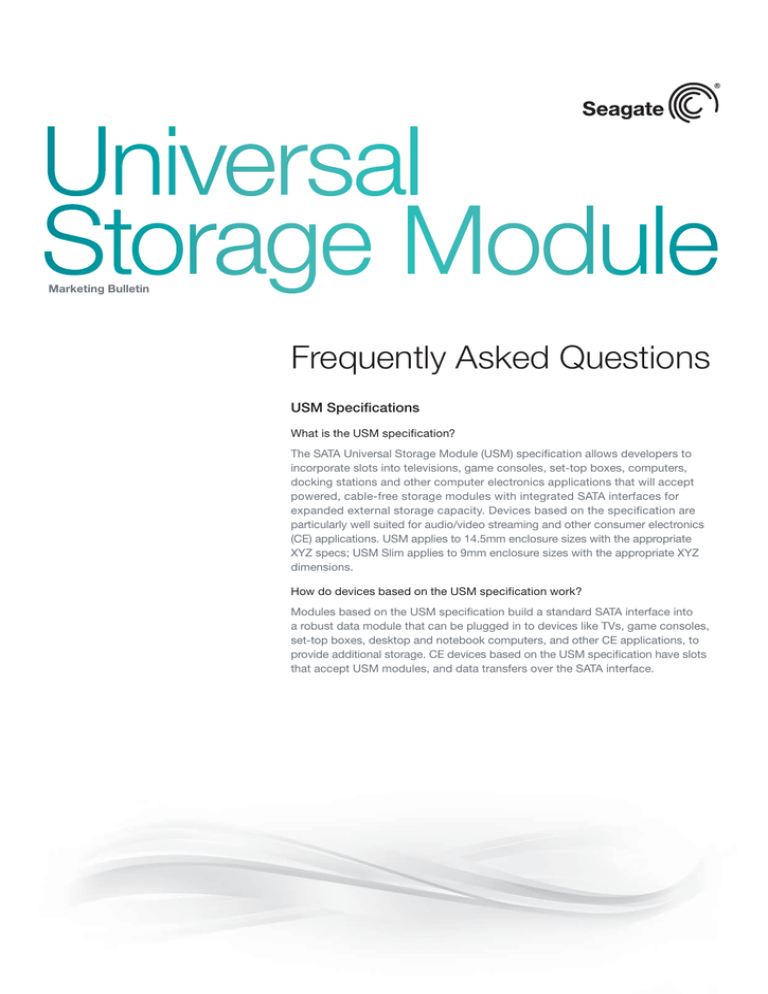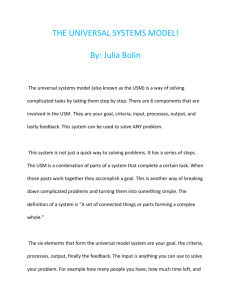
Universal
Storage Module
Marketing Bulletin
Frequently Asked Questions
USM Specifications
What is the USM specification?
The SATA Universal Storage Module (USM) specification allows developers to
incorporate slots into televisions, game consoles, set-top boxes, computers,
docking stations and other computer electronics applications that will accept
powered, cable-free storage modules with integrated SATA interfaces for
expanded external storage capacity. Devices based on the specification are
particularly well suited for audio/video streaming and other consumer electronics
(CE) applications. USM applies to 14.5mm enclosure sizes with the appropriate
XYZ specs; USM Slim applies to 9mm enclosure sizes with the appropriate XYZ
dimensions.
How do devices based on the USM specification work?
Modules based on the USM specification build a standard SATA interface into
a robust data module that can be plugged in to devices like TVs, game consoles,
set-top boxes, desktop and notebook computers, and other CE applications, to
provide additional storage. CE devices based on the USM specification have slots
that accept USM modules, and data transfers over the SATA interface.
Universal Storage Module
What is the SATA-IO committee?
The Serial ATA International Organisation (SATA-IO) is a
consortium of over 200 members from various technology
companies, including Seagate, WD, SanDisk, Toshiba, Intel,
Microsoft and others (www.sata-io.org/membership/
member_listings.asp).
When can we expect the USM specification to be available?
A USM-enabled gaming PC from ASUS, with removable
Seagate Storage.
What does the USM specification define?
SATA-IO made the first announcement about USM
becoming a standard on 4 January, 2011, and released the
SATA 3.1 specification on 18 July, 2011, which includes the
design requirements for USM (www.sata-io.org/documents/
SATA-IORevision31_PRfinal.pdf). The USM Slim standard
was announced on 6 June, 2012, and will be added to the
SATA 3.2 specification available in the third quarter of 2012
(available now to members for download as file “TP_041_
SATA_TechProp_113v0_9mmUSM”).
The USM specification defines how the SATA interface is
integrated into a module form factor and how power is provided
to the interface. A complementary specification in the Small
Form Factor Committee (SFF) defines the form factor and
size requirements for USM products. The drive inside the disc
enclosure can be any vendor and configuration type, such
as SATA II, SATA III, hybrid or solid state drive.
Does the USM specification address content protection?
What benefits do devices based on the USM specification
provide?
Seagate® USM Partner Programme
Devices based on the USM specification extend the speed
and reliability of SATA technology from the PC storage
space to a variety of CE applications like televisions, game
consoles and set-top boxes, as well as desktop and notebook
computers. Also, USM devices are the first products to
provide a portable, 3 Gb/s and 6 Gb/s powered SATA solution
for consumer applications, enabling consumers to instantly
access films, music and other content, and to transfer content
between devices without having to carry a cable, connector
or power supply.
What transfer rates does the USM specification support?
The USM specification supports the current SATA data rate of
6 Gb/s. Devices based on the specification will also be able to
degrade their speed for compatibility with products designed
to previous-generation SATA specifications.
Do devices based on the USM specification require any
additional cables or equipment?
No. Because the USM specification integrates the SATA
interface into a module form factor, USM modules can simply
be plugged in to host devices in order to deliver additional
storage capacity.
No. The USM specification defines how the SATA interface
is integrated into a module form factor. Implementation
of content protection technologies will be addressed by
individual device manufacturers whose products support the
standard (important for STB/DVR manufacturers).
What is the Seagate USM partner programme?
This programme allows third-party companies to incorporate
slots on their products to support USM external hard drives.
This initiative is a certification process whereby Seagate will
qualify products from participating companies to incorporate
slots that meet the specifications of accepting portable
2.5‑inch drives that meet the USM or USM Slim standard. The
programme will establish placement of both slot-based CE
devices as well as certification of third-party external storage
modules. Since the Seagate ultra-portable drives are also
standardised on the new SATA USM specification, third-party
manufacturers can build USM certified products to accept
a 2.5-inch ultra-portable external hard drive.
How can a company sign up to work with Seagate?
If you are interested in becoming a Seagate USM partner, sign
up at www.seagate.com/solutions/usm.
Universal Storage Module
USM Ecosystem Partners
Seagate USM Products
Who are the current USM ecosystem partners and what do
they make?
Which Seagate external products meet the USM standard?
• Antec (multiple desktop PCs with USM slot and an aftermarket kit for desktop PCs)
• Thermaltake (multiple desktop PCs and an after-market kit
for desktop PCs)
• Ionics (media player)
The Seagate Backup Plus Portable Drive and the Seagate
GoFlex® Ultra-portable and Ultra-portable Pro 2.5-inch
(14.5mm) hard drive family in 320 GB, 500 GB, 750 GB and
1 TB meet the USM specification. The Seagate Slim Portable
Drive (320 GB/500 GB) meets the USM Slim specification.
Will the 1.5 TB (22mm) drive become part of the
USM standard?
• GIEC (media player)
• Mele (media player, STB)
• Hisense (media player)
• Pogoplug (MediaShare NAS)
• Lenovo (K4 Series desktop gaming PC)
• Verbatim (Verbatim-branded USM drive)
• Lenuss (STB, media player, Lenuss-branded USM drive)
• Leader (desktop PC)
• Palconn (OEM-branded USM drive enclosures, cables,
readers and slots for OEMs)
• Heran (plasma TV with USM slot)
• ASUS (CG8580 desktop gaming PC)
There are no plans at present to take the 22mm drive to the
committee.
Is Seagate GoFlex Satellite™ mobile wireless storage
a USM device?
No. The GoFlex Satellite device is 22mm tall and therefore
it is not USM-compatible. However, the GoFlex USB 3.0 cable
that comes with it is a USM cable.
Which Seagate GoFlex and Seagate Backup Plus interface
cables meet the USM standard?
All Seagate GoFlex, Backup Plus and Thunderbolt adapter
cables meet the USM standard, regardless of the device they
come with.
• Dell (Dell-branded USM drive)
• A-Tec (RAID NAS with USM slot)
• Entone (OEM STB/DVR with USM slot)
• I-O DATA (USM module and media player; STB available
CY12Q3)
• Samsung (USM module; available CY12Q2 in Korea)
• Calcomp (USM module, USM slot)
• Quanta Storage (QSI) (USM module, USM slot)
www.seagate.com
AMERICAS
ASIA/PACIFIC
EUROPE, MIDDLE EAST AND AFRICA
Seagate Technology LLC 10200 South De Anza Boulevard, Cupertino, California 95014, United States, +1 408 658 1000
Seagate Singapore International Headquarters Pte. Ltd. 7000 Ang Mo Kio Avenue 5, Singapore 569877, +65 6485 3888
Seagate Technology SAS 16-18 rue du Dôme, 92100 Boulogne-Billancourt, France, +33 1 41 86 10 00
© 2012 Seagate Technology LLC. All rights reserved. Seagate, Seagate Technology and the Wave logo are registered trademarks of Seagate Technology LLC in the United States and/or other countries.
GoFlex and GoFlex Satellite are trademarks or registered trademarks of Seagate Technology LLC or one of its affiliated companies in the United States and/or other countries. All other trademarks or registered
trademarks are the property of their respective owners. When referring to drive capacity, one gigabyte, or GB, equals one billion bytes; and one terabyte, or TB, equals one trillion bytes. Your computer
operating system may use a different standard of measurement and report a lower capacity. In addition, some of the listed capacity is used for formatting and other functions, and thus will not be available for
data storage. Seagate reserves the right to change, without notice, product offerings or specifications. MB623.1-1209GB, September 2012




